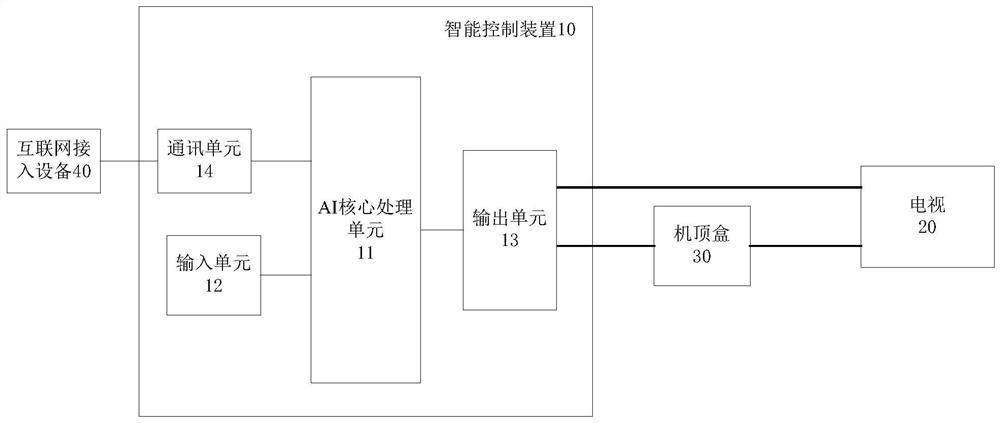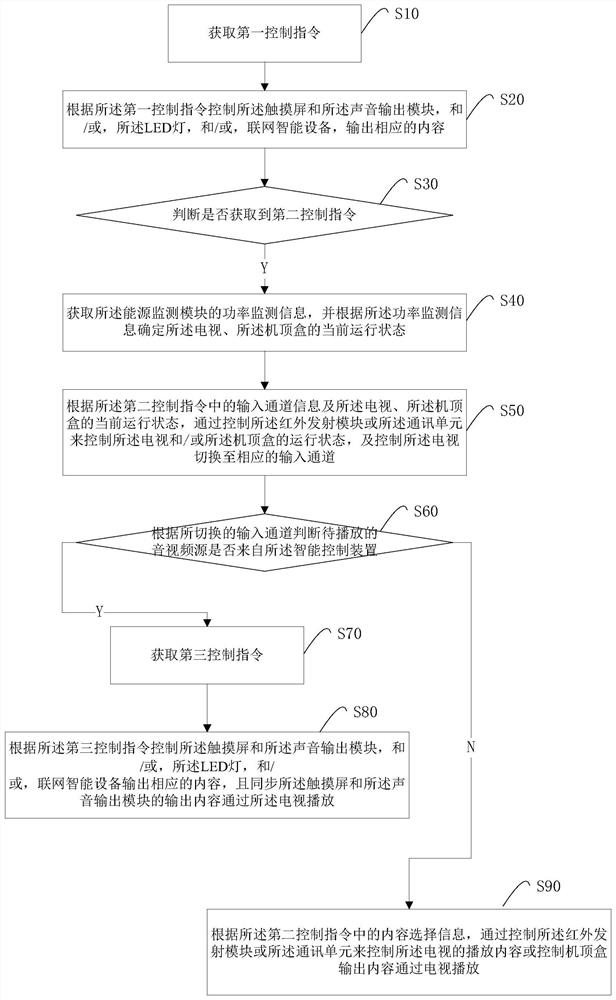[0003] 1). TV operation is cumbersome: TV, TV
remote control, set-top box, set-top box remote control, router, optical modem,
fiber optic box, multiple power adapters, sockets, various connection cables, etc. These smart TVs must be installed for normal operation , and the installation of these devices has its own requirements (such as the installation of the set-top box near the TV, the installation of the router at a height of more than 1M, the cable connection between the optical modem and the set-top box, router, telephone, etc.), and these devices cannot be installed in the traditional weak box. It leads to cluttered piles of devices and cables near the TV. Operations such as switching on and off of these devices, multiple remote controls, and channel switching are cumbersome; and various selection operations such as content selection,
Internet content selection, viewing history, and search for TVs and smart TVs It is not convenient, and it mainly relies on the remote control operation, and the operation method is relatively simple; the set-top box + TV mode also adds the manual power switch of the set-top box, content source selection, content selection, viewing history and search. The most important set-top box is also operated by the remote control, although The remote control can be shared through
infrared learning, but the cumbersomeness of user operations continues unabated
Therefore, the cumbersome operation of set-top box + TV or smart TV is daunting.
[0004] 2). Simple functions: Compared with mobile phones, the replacement cycle of TVs is much longer. If there is no quality problem, it can be used for at least 5 years or even longer. If the TV is more and more intelligent, new functions , High configuration requires users to speed up the frequency of TV updates, and TV is a C-end household
consumer product, so the price factor is the first, and the smarter the smart TV, the higher the cost, and the higher the price, the lower the user's desire to buy , which is why the configuration of TVs in the market is generally low, and the lower the configuration, the worse the user experience, and the worse the user experience, the less willing to consume, thus forming a vicious circle
Because TVs are dominated by large display screens, various factors such as equipment appearance, installation height, screen-to-body ratio,
signal interference, heat dissipation, cost, and
energy consumption also make it impossible for TVs to have many built-in smart modules, such as smart phones on the market. Some TVs have built-in cameras, some have built-in
microphone arrays and other advanced intelligent modules, but they lack
perception systems, and
perception sensors generally have specific installation requirements. Even if all the perception sensor systems are built in, the TV has greatly increased In this way, the willingness of users to purchase will be greatly reduced. Therefore, TV functions and multiple constraints are irreconcilable contradictions, which
restrict the expansion of TV functions.
[0005] 3). Lack of content / application: With the demand and development of marketization, the profit model of smart TV has gradually changed from a single hardware competition to an integrated industrial chain of "content + service + hardware". Manufacturers"
cooperation model, launching smart TV services to meet
consumer needs; the richer the content of the TV, the higher the requirements for the
system configuration of the TV, the high configuration leads to high costs, and because the TV is a C-type consumption, users Willingness to purchase will decline, which in turn restricts TV content and services. In addition, with the gradual promotion of the set-top box + TV model, whether the TV itself needs a powerful intelligent system is a problem
[0006] 4). Poor experience: The addition of smart systems has not significantly improved the experience of TV, and the so-called smart TVs are just castrated smart systems. Instead, merchants generally embed a large number of advertisements in the name of smart TVs. The reason for embedding Advertising is mainly a business model that relies on low prices to seize the market in the early stage, causing TVs to become "advertising machines" and a topic of complaints among the people; in addition, the poor configuration of intelligent systems leads to long buffering times or freezes when watching online videos and large-scale interactive games , the experience effect is not ideal; a good TV experience is not independent, but also needs the surrounding environment to set off, such as lighting scenes with different atmospheres during TV experience, and traditionally to achieve such effects, it is necessary to install
intelligent lighting and establish a control communication system , New installation or old installation of
smart lighting will face many problems, and most users will basically not do this; although some TVs already support
wireless projection, but the operation of searching for
pairing confirmation before projection cannot be saved, and there is still a problem that the projection is difficult to fill the screen Display and screen projection are not clear enough, the sound freezes, and the smartphone can no longer do other work after screen projection; some smart TVs have built-in
microphone arrays, but the TV is usually in a dormant state. If the
microphone array is set independently, there is TV
delay. In response to the problem, if the
microphone array is not installed independently and the smart TV is turned on for a long time, it will generate a lot of
energy consumption and affect the life of the TV; if the
microphone array is not installed, the smart TV will not have a good experience, so the experience of the TV is different from the
system configuration, Various factors such as sensors,
delayed response,
signal interference, heat dissipation, cost, and
energy consumption restrict each other, resulting in an unsatisfactory TV experience
[0007] 5). Lack of core gateway: Smart home service is a
livelihood project that is closely related to thousands of households. The home
smart gateway is the heart of
home intelligence. Through it,
system information collection, information input, information output, centralized control, remote control, Linkage control and other functions
As far as home
smart products are concerned, there are already many
smart products, such as smart TVs, smart screens, smart speakers, smart panels, building
intercom extensions, smart routers, smart phones, service robots, sweeping robots, smart cameras, and alarm devices ,
Internet access devices, smart boxes, smart light bulbs, etc., but none of these smart devices can play the role of a core gateway, because home users have a lot of needs, and these independent smart devices are limited to solve the needs of home users, and users are not willing to buy. Not strong; for example, although TVs or smart screens have the
advantage of just needing a
large screen, there are conflicts in content, functions, and experience with costs. The most important thing is that TVs or smart screens have limited needs; Gateway concepts, such as distributed
smart lighting panels, but this is limited to
smart lighting; there is also another concept of all 5G networking, thinking that all my smart devices can communicate through the 5
G network, but I don’t know the hardware and operation of 5G There is a fee, so the home core gateway equipment must integrate the characteristics of the needs of home users, learn from each other, and be able to comprehensively solve the needs of users
[0008] To sum up, regardless of traditional TV, smart TV, or smart screen, TV is the only big screen just needed by the family, and it cannot be replaced or canceled. Problems such as lack of smart TVs and unsatisfactory user experience not only
restrict the popularization and promotion of smart TVs, but also restrict users' demand for smart systems, which in turn restricts the development of smart homes.
 Login to View More
Login to View More  Login to View More
Login to View More 

